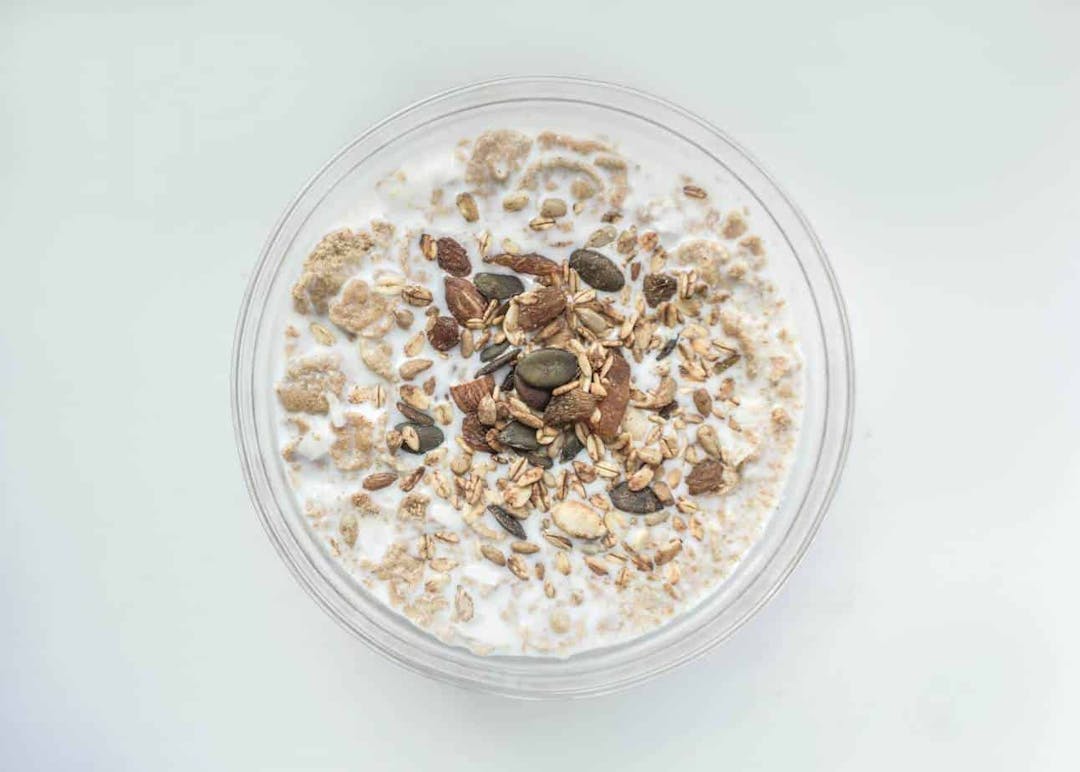


Find foods you can eat.
How to Incorporate More Fiber into Your Diet
Published on November 9, 2021As a registered dietitian, fiber is a topic that I’m frequently asked about. We all know that we should be eating fiber for our health, but what exactly does fiber do for us and how can we make sure we’re getting enough? Additionally, is it possible to eat too much fiber? I hope to clear things up and provide actionable tips to help you meet your fiber needs.
What is fiber and why is it important?
Fiber is a type of carbohydrate found in plant-based foods that our bodies lack the enzymes to digest. There are two main types of fiber, soluble fiber and insoluble fiber.
Soluble fiber holds onto water and forms a gel-like material in our digestive tract. Due to this gelling property, it promotes blood sugar stability by helping to slow the rate at which sugar is absorbed into our blood from carbohydrates that we eat. It also may lower cholesterol by binding with bile acids in our intestine, causing them to be excreted. Our body then must pull from its own cholesterol to make more bile acids, lowering our blood cholesterol in the process. Lastly, soluble fiber promotes optimal digestive function by aiding in bowel regularity and can help to relieve both diarrhea and constipation.
Insoluble fiber is often referred to as “roughage” and does not hold on to water. It speeds up GI transit time so that food moves through our digestive tract more quickly, promoting regularity. It also adds bulk to the contents of our intestines. This bulk provides resistance against the walls of our colon, helping to prevent diverticular disease by keeping the colon walls strong and healthy.
Both types of fiber help us to feel full after eating, promoting a healthy weight. Additionally, both soluble and insoluble fiber can help to lower your risk for developing certain cancers, especially colon cancer and breast cancer. Some soluble and insoluble fibers are also prebiotics, meaning they selectively feed our good gut microbes thereby encouraging a healthy gut microbiome.
Where do we get fiber from?
Fiber is naturally found in plant-based foods including fruits, vegetables, nuts, seeds, whole grains, beans, and legumes as well as in supplements. Soluble fiber is primarily found in the flesh of fruits and vegetables, the inner portion of beans and legumes, and in certain grains. Insoluble fiber is mostly found in leafy greens, skins of fruits and vegetables, the outer portion of grains, and in nuts and seeds.
As with most nutrients, it’s best to obtain most of our fiber through diet, especially since fiber tends to be found in highly nutritious foods. Additionally, while it’s important to consume enough grams of fiber, obtaining fiber from a variety of sources is also key. This is because different fibers confer various benefits and if we’re only consuming a few types of fiber, we’ll be missing out on some of these benefits.
How much fiber is enough?
The National Academies of Sciences, Engineering and Medicine (NASEM) has set the “adequate intake” (AI) level for fiber at 38 grams per day for men and 25 grams per day for women aged 18-50. The NASEM recommends 30 grams per day for men over 50 and 21 grams per day for women over 50. These specific fiber recommendations were determined based on the amount of fiber consumption that is associated with protection against coronary heart disease, however, research suggests that further health benefits may result from even higher fiber intakes.
It’s estimated that the average American only consumes between 10 and 15 grams of fiber per day and that a mere 7% of US adults are actually meeting the AI for fiber. This raises significant concerns because low fiber intakes are associated with increased risk for colon cancer, breast cancer, cardiovascular disease, diverticulosis, type 2 diabetes, metabolic syndrome, and more. While getting the recommended 21-38 grams of fiber each day can seem difficult, with a little planning and creativity, you can easily meet your needs. Here are a few tips to help ensure that you’re getting enough:
Start your day with a breakfast smoothie
Smoothies are an excellent opportunity to add more fiber-rich fruits and vegetables into your diet first thing in the morning, as well as incorporate other fiber sources like nuts and seeds. In addition to adding fruits like banana and frozen berries, you can also add vegetables. Frozen riced cauliflower lends a thick, frozen texture to smoothies while providing around 3 grams of fiber per cup. While it may sound strange to put cauliflower into a smoothie, you won’t taste it as long as you add enough fruit and other flavorful ingredients! For those following the low FODMAP diet or avoiding cauliflower, try frozen diced zucchini instead. Zucchini is considered low FODMAP in portions of 1/3 cup or less, which provides around 2 grams of fiber. A generous handful of spinach or baby kale will also increase the fiber content of your smoothie by 1-3 grams without affecting taste much. And for a chocolatey flavor along with a fiber boost, throw in a tablespoon of cacao powder – it’ll provide you with an extra 2 grams of fiber.
Aim to fill half of your plate with vegetables for at least 2 meals each day
Non-starchy vegetables contain anywhere from 2-5 grams of fiber for 1 cup raw, or ½ cup cooked depending on variety. When working with clients, I generally recommend that they aim to include vegetables in at least 2 meals each day (bonus points for getting them into 3 meals!). If we aren’t making a conscious effort to incorporate veggies into our meals, it’s easy to forget about them. Then before we know it, it’s dinner time and we haven’t had a vegetable all day. By that time, it’ll be hard to meet your daily fiber needs with just one meal, especially if you didn’t include many other fiber sources with breakfast or lunch. A general rule of thumb is to fill about half of your plate with vegetables at most meals. This helps ensure that you’re getting enough fiber along with micronutrients.
Snack on fruit, nuts, and seeds
Snacking on fiber-rich foods can help you to easily meet your fiber needs. Fruit, nuts, and seeds make for tasty high-fiber options. Blackberries and raspberries happen to be exceptionally high in fiber—just 1 cup of blackberries or raspberries contains a whopping 8 grams!
The flesh of apples is rich in pectin, a type of soluble, prebiotic fiber that promotes gut health, whereas apple skins are rich in insoluble fiber. 1 medium-sized apple will provide over 4 grams of fiber. Pears are also rich in both types of fiber, providing 6 grams per medium-sized pear.
Pair your fruit with a handful of nuts or seeds to add protein, healthy fats, and extra fiber so you feel fuller for longer. Some of my favorite high-fiber options include almonds, which contain 3.5 grams of fiber for a handful, pumpkin seeds for 2 grams of fiber per ¼ cup, shelled pistachios and sunflower seeds which both have 3 grams per ¼ cup, and pecans, which contain 2.5 grams per ¼ cup.
Sprinkle ground chia seed, flaxseed, and oat bran into foods
Adding ground chia seed, ground flaxseed, and oat bran into smoothies, oatmeal, cold cereal, yogurt, pancake or waffle batter, and baked goods will instantly up their fiber content. Chia seeds contain 10 grams of fiber in just 2 tablespoons and flaxseeds have 6 grams in 2 tablespoons.
Oat bran comes from the outer layer of the oat groat and contains a special type of prebiotic fiber called beta-glucans. Beta-glucans have been studied for their ability to reduce cholesterol, improve blood sugar control, and optimize immune function. 1/2 a cup of oat bran has about 7 grams of fiber.
Keep the skins on fruits and vegetables
Leaving the skins on fruits and vegetables like apples, pears, potatoes, and cucumbers will add approximately 1-3 extra grams of insoluble fiber. While this may not seem like much, every gram counts and over the course of the day, those fruit and veggie skins can really add up.
Select whole grains over refined grains
Whole grains like brown rice, quinoa, barley, bulgur, farro, millet, and whole wheat contain all parts of the grain including the fiber-rich outer layer, called the bran. Choosing whole grains and whole grain products over their refined counterparts will provide extra fiber and other nutrients like B vitamins. Try ordering your sushi with brown rice, swapping your white bread and pasta for whole wheat versions, and experiment with cooking different whole grains like barley and quinoa to add as a side dish to meals.
Incorporate beans and legumes into your day
Beans and legumes like chickpeas, black beans, cannellini beans, split peas, edamame, and lentils are excellent sources of prebiotic fiber, plus if you’re plant-based, they’re a great way to incorporate protein into your diet. Most contain around 5-9 grams of fiber in just ½ a cup. If you’re not a bean person or have trouble digesting them, try whipping up a dip like hummus or black bean dip to enjoy as a fiber-rich snack with some sliced veggies or whole grain crackers. These dips are not only tasty, but blending and pureeing beans and legumes helps to break down some of the fiber, making it easier to digest. If you’re cooking dried beans, soaking them in water overnight before cooking helps leach out some of the more gas-producing fibers that they contain, also aiding in tolerance. For those following the low FODMAP diet, you don’t have to avoid beans and legumes entirely. Canned chickpeas in a ¼ cup portion size, canned lentils in a ½ cup portion size, and shelled edamame in a ½ cup portion size are all low FODMAP compliant.
Embrace avocado
Despite its creamy texture, avocado is surprisingly rich in fiber, with an impressive 13 grams per avocado. If it fits your dietary needs, spread mashed avocado on whole grain toast with a pinch of salt and some lemon juice, add sliced avocado to sandwiches, wraps, and salads, and have guacamole as a snack with whole grain tortilla chips or carrot sticks.
Have a few meatless meals each week
Since fiber is only found in plants, plant-based meals are inherently high in fiber. Simply swapping out an animal protein for beans, legumes, tempeh, or quinoa every so often will automatically boost the fiber content of your meal.
Experiment with bean and legume-based pastas
If you’re not a fan of whole wheat pasta, are gluten-free, or just want to switch things up periodically, try a bean or legume-based version. Nowadays you can find spaghetti and lasagna sheets made from chickpeas, fettuccine made from edamame, and penne made from lentils and black beans. These pastas contain anywhere from 6 to 13 grams of fiber per serving. They’re also higher in protein and more filling compared to regular pasta.
Can you consume too much fiber?
Fiber is a vital dietary component, however, it is possible to overdo it. Increasing your fiber intake too quickly can cause GI distress. Additionally, certain types of fibers that are highly fermentable by our gut bacteria may trigger gastrointestinal symptoms for those with Irritable Bowel Syndrome (IBS). While most people benefit from a high-fiber diet, it may not be safe for certain populations such as those with stricturing Crohn’s disease or a history of intestinal obstructions. Further, excessive fiber intakes (we’re talking around 70 grams per day or more) can lead to malabsorption of certain minerals like calcium, magnesium, zinc, and iron, as the excess fiber binds to the minerals, blocking absorption. Luckily, it’s very difficult to consume over 70 grams of fiber from food sources alone, as fiber is quite filling.
When increasing your fiber intake, it’s best to start “slow and low” to allow your body (and gut bacteria) to adjust. It’s also important that as you increase your fiber intake, you also drink plenty of water to help it move through your digestive tract properly. Cooking vegetables and blending or pureeing fruits, vegetables, beans, and legumes may improve your tolerance to a higher fiber intake, since these preparation methods help soften or break down harder-to-digest fibers. You’ll still reap the benefits of fiber, it’ll just be easier for your body to handle.
Before making any major dietary changes, it’s best to consult with your healthcare team to make sure that it’s safe for you to do so.
Summary
Fiber plays many important roles in our bodies and the majority of Americans aren’t getting enough. While it may seem challenging to get your recommended 21-38 grams or more per day, there are many fiber-rich foods to choose from that suit a variety of dietary needs and provide you with what you need.
Struggling to find food that fits your needs? Try the Fig app! Tell Fig any ingredients you need to avoid, and Fig will show you thousands of products without those ingredients. You can also scan products at the grocery store to see if they fit your needs! Fig works with ANY ingredient-based diet, allergy or ingredient.
 A Dietitian’s Guide to Alternative Milks
A Dietitian’s Guide to Alternative Milks 11 Tips for Coping With Dietary Restrictions Around the Holidays
11 Tips for Coping With Dietary Restrictions Around the Holidays